Update: last updated on 15/03/2015.
Fitz Roy - Goretta (north) pillar
9. Casarotto
9.1 Diedro Directo
9.2 Kearney-Knight
9.3 Chimichurri y Tortas Fritas
9.4 Lindblade-Whimp
9.5 Gringos Perdidos
9.6 Acceso Oeste
9.7 Crux del Sur
9.8 Amaro Vecchia Romana
1250m 65˚ 6c (6b C1)
Renato Casarotto (Italy), 19/1/1979.
Description. An extraordinarily route; its length, rock quality and position make it one of the finest routes in the whole massif. It can easily be climbed mostly free, with the exception of a few short sections that are often icy and therefore require aid (a free ascent of the Casarotto with Kearney-Knight variation has been done, but not of the original Casarotto line).
Climb an obvious couloir leading to the col del Bloque Empotrado (chockstone), which involves easy mixed terrain for 300 meters. Three pitches above the block traverse left for 30 meters to reach a dihedral and chimney system, which leads to cracks near the pillar’s edge higher up, and eventually the top of the pillar. From this point two short and awkward diagonal rappels are necessary to reach the final 300-meter headwall. This last section involves some of the hardest climbing on the route (free at 7a but often icy) as well as low angle ice slopes that require basic ice gear. There are bivouac ledges at the col del Bloque Empotrado, at the top of the pillar and at the col at the base of the final headwall.
Many ascents have been made to the top of the pillar, but few parties continue to the summit, and most climb significant variations to the original line (see Kearney-Knight, Chimichurri y Tortas Fritas, Lindblade-Whimp), which in its entirety might still be unrepeated.
History. This route was first attempted in early 1978 by a large Italian team led by Giuseppe Caneva (CAI Morbegno), that included Renato Casarotto. They were forced to retreat after climbing 250 meters of the pillar. On his second trip to try it, Casarotto was deserted by his teammates Luigi Zen and Giovanni Maiori, and decided to try the route alone, with the support of his wife Goretta, after whom the pillar is named. He fixed ropes to the top of the pillar. His was the first solo ascent of the mountain and till today the only solo new route in the entire peak. His vision and perseverance were likely unmatched at the time. This was one of the finest achievements of the great Italian “Maestro”, who made many outstanding solo ascents before his untimely death on K2 in 1986 while trying to complete the so called “Magic Line”.
Approach. Laguna de los Tres to Paso Superior to Glaciar Piedras Blancas Superior.
Descent. It is possible to descend the route, but since climbing back to the top of the Goretta pillar is difficult a traverse of the mountain descending the Francesa is recommended.
Bibliography.
Caneva: CAI-Rivista Mensile 1978/7-8 p.292.
Casarotto: Rivista della Montagna 85 p. 58-67, p. 85; AAJ 1980 p. 383-386; Mountain 69 p.15-16; Mountain 95 p.28-33; Alpi Venete # autuno-natale 1979 p.11-114; Casarotto R. and G. (1996) Una vita tra le montagne, De Agostini, Novara (p.32-41); Traverso G. (2008) La Via della Montagna, Priuli&Verlucci, Torino, Italy (p.77-96); Moro R. (1980/2) Fitz Roy - Pilastro Nord, Natura e Fotografia, Scarpa, Asolo (TV). |
Photos (click to enlarge)
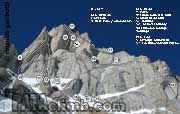
Fitz Roy Goretta pillar - overview 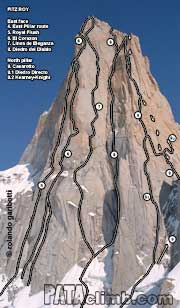
Fitz Roy east face and Goretta pillar 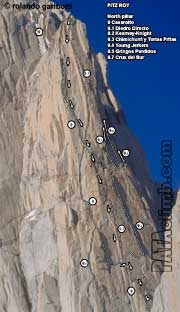
Fitz Roy Goretta pillar 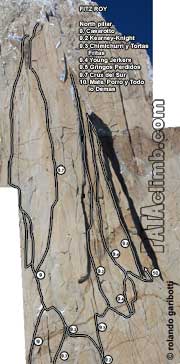
Fitz Roy Goretta pillar 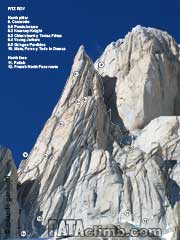
Fitz Roy Goretta pillar 
Fitz Roy Goretta pillar 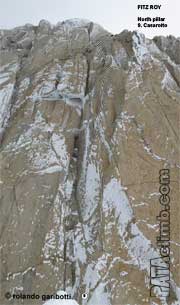
Fitz Roy Goretta pillar, upper part
|
9.1 Diedro Directo
450m 5+ A3
Ben Gilmore and Brady Robinson (USA), 18-20/2/2000.
Description. This route is a difficult 12-pitch start to the Casarotto and involves six free climbing pitches followed by several difficult A3 pitches (1250m altogether). There is a decent bivy ledge on the ninth pitch.
History. Gilmore and Robinson fixed eight pitches over three days 8/2 to 10/2, then fixed two more pitches (450 meters of rope total), and on their final push climbed to the summit and descended the Franco-Argentina, traversing the peak in three days, with a third bivy at the Brecha. They placed only three bolts in their line, all three at belays and after the ascent they returned to their route to retrieve all their fixed lines, leaving their line clean. John Catto, Peter Gallagher and Mark Hesse (USA) had attempted this line in early 1999 climbing the first seven pitches.
Approach. This line starts 50 meters above the bergschrund of the couloir leading to the Col del Bloque Empotrado.
Bibliography.
Catto: AAJ 1999 p.336. |
9.2 Kearney-Knight
300m 6b+
Alan Kearney and Robert Knight (USA), 21-24/12/1984.
Description. This superb 11-pitch variation to the Casarotto has become the preferred line up the Goretta pillar, mostly because it involves less “wide” climbing than the Casarotto route. Three pitches above the col, traverse right for one and a half pitches, and climb the elegant cracks directly above, traversing back to the original line not far below the pillar’s “nose”.
History. Kearney and Knight completed the ascent climbing alpine style over four days. Free ascent: Bean Bowers and Josh Wharton, 2/2006, in 15 hours from the bergschrund to the top, 24 hours round trip from Paso Superior.
Pro. Two each camalots to #4, nuts, Rps, two ice screws.
Bibliography.
GHM 1985 p.16; Climbing 90 p.36-43; AAJ 1986 p.101-109; Mountain Review 2 p.46-53; Kearney A. (1993) Mountaineering in Patagonia, Cloud Cap, Seattle, p.49-56. |
9.3 Chimichurri y Tortas Fritas
450m 6c+
Kurt Locher and Marco Pedrini (Switzerland), 29/12/1985, to the top of the Goretta pillar.
Description. This is a splendid variation to the Casarotto and Kearney-Knight routes. Climb the first three pitches of the Casarotto, to where the Casarotto heads left and the K-K heads right, and climb two pitches up a steep crack to the make an easy one pitch traverse into the right facing corner of the Kearney-Knight. Two pitches later, where the K-K moves left continue straight to a short face traverse right, climbing over a red colored dike. Immediately after the short traverse climb straight up, into the first dihedral right of the pillar’s “nose", moving later into the second, climbing several unprotectable off-width cracks along the way.
History. Locher and Pedrini climbed to the top of the pillar in one day from Paso Superior. Their biggest cam was a number 3 Friend! While walking across the col to reach the upper headwall Pedrini slipped on verglas and fell, dislocating his shoulder badly enough that they were forced to retreat. The route name refers to typical Argentinean grub, chimichurri is a spicy sauce to accompany grilled meat, and tortas fritas are fried bread. In late 1993 Andrew Lindblade and Athol Whimp climbed this line until past the "red dike" traverse, to then continue right, to establish their own variation. Until recently it was thought that they had repeated Chimichurri, but corroboration against Pedrini's original topo proved otherwise. Chimichurri y Tortas Fritas still awaits an integral ascent to the summit.
Pro. Doubles to #4, one #5, stoppers.
Bibliography.
Pedrini: Mountain 110 p.20-23; AAJ 1987 p.103-108; Alp 12 p.14; Desnivel 26 p.13, p.35-39.
Lindblade: Wild 1994/w, p. 40-45. |
9.4 Lindblade-Whimp.
300m 7a C1
Andrew Lindblade (Australia) and Athol Whimp (New Zealand), 31/12/1993 to 2/1/1994 to the summit.
Description. Yet another fine way to climb the Goretta pillar. Follow the Chimichurri y Tortas Fritas line until past the short "red dike" face traverse. Move 35 meters down and right, across a faint ledge, to a 60 left facing dihedral that leads to a broad ledge (good bivy spot). From here climb an obvious system straight up, likely joining the last two pitches of Chimichurri before the summit of the Goretta pillar.
History. The first ascent was done alpine style over three days, with two bivies. In 2005 Slovenes Rok Sisernik, Aljaz Tratnik and Rok Zalokar repeated this line and unaware that Lindblade and Whimp had not followed the original Chimichurri line, thought to have done a new variation, which they named Young Jerkers.
Pro. Two each camalots to #4, camalot #5, nuts, some pitons, two ice screws. |
9.5 Gringos Perdidos
250m 6c
Jesse Huey and Toby Grohne (USA), 2008.
Description. Yet another fine way to climb the Goretta pillar. Climb the Casarotto to the Kearney-Knight to Chimichurri y Tortas Fritas to Lindblade-Whimp, to reach the big ledge one and a half pitches above the “red dike" face traverse. At the ledge walk west -right- about 60 meters, to an obvious crack system in the arête that marks the right edge of the steep wall above the ledge -the dihedral further right is where Mate, Porro y Todo lo Demás climbs. Gringos Perdidos climbs 6 to 8 new pitches involving 6c freeclimbing. Likely the last 2 or 3 pitches of Gringos Perdidos are shared with the Lindblade-Whimp and Chimichurri y Tortas Fritas.
History. The first ascent was done alpine style.
Pro. Two each camalots to #4, one camalot #5, nuts, two ice screws. |
9.6 Acceso Oeste
It is possible to climb into the Kearney-Knight from the west. Although this would initially seem like a good option as it avoids the east facing couloir to the Col del Bloque Empotrado, the climbing is somewhat hard and slow, so it is not recomended. In 2006 Americans Kate Rutherford and Mikey Schaefer climbed a line to reach the Kearney-Knight before retreating due to bad weather. In 2009 Doerte Pietron (D) and Rolando Garibotti (ARG) climbed a paralel line to reach the Kearney-Knight along which they continued to the top of the Goretta Pillar. |
9.7 Crux del Sur
150m + 250m 6c
Luciano Fiorenza (Argentina) and Sacha Gal (Switzerland), 2/2012; to the top of the Goretta pillar.
Description. Another great option up the Goretta pillar. Climb the first three pitches of the Casarotto then two more along Chimichurri y Tortas Fritas, and where Chimichurri heads right continue straight, climbing 4 pitches to join the Kearney-Knight for a pitch before heading right to climb a steep dihedral that marks the left edge of the pillar’s “nose.”
History. The ascent was completed alpine style over two days, approaching via the Casarotto and retreating due to bad weather from the top of the pillar. The name refers to the obvious red dikes cross half way up the route, which they had estimated would be the crux, but turned out not to. Still awaits an integral ascent to the summit.
Pro. Two each camalots to #4, one #5, nuts, Rps, 2 ice screws. |
9.8 Amaro Vecchia Romana
130m 7a+
Matteo Della Bordella, Luca Schiera (IT) and Sylvan Schupbach (CH), 2/2015.
Description. Climbs four pitches up just left of the pillar’s “nose.”
|
Please Do Not Reprint This Article.
This article is copyrighted. Please do not reprint this article in whole or part, in any form, without obtaining written permission.
Feedback.
if you find any mistakes or if you have additional information, please go to the contact page and let us know. |
Cerro Fitz RoySoutheast face1. Francesa 1.1 Franco-Argentina link-up 2. Línea Hermanos Gallego 3. Nott-Reichert attempt28. Un Mar de Sueños East face 4. Pilar Este 5. Royal Flush 6. El Corazón 7. Línea de Eleganza 8. Hudičeva Zajeda - Diedro del Diablo Goretta (north) pillar 30. The Real Kekec9. Casarotto 9.1 Diedro Directo 9.2 Kearney-Knight 9.3 Chimichurri y Tortas Fritas9.4 Lindblade-Whimp 9.5 Gringos Perdidos9.6 Acceso Oeste9.7 Crux del Sur9.8 Amaro Vecchia Romana10. Mate, Porro y Todo lo Demás10.1 Guasos on the Rock27. Al Abordaje! North face 11. Polaca 12. Francesa Cara Norte 13. Clínica de Aventura29. Samba do Leao14. Tehuelche 14.1 The Hoser Chimney 15. El Flaco con Domingo 31. Persiguiendo el Avión16. Pretty Bird West face 17. Filo Noroeste, Afanassieff 17.1 Los Últimos Días del Paraíso17.2 Le Chercheur d'Absolu 17.3 Attempt 17.4 Rocamora-Tarditti 17.5 Tango Libre 18. Supercanaleta 18.2 No Brain, No Pain 19. Ensueño20. Historia sin Fin Southwest face 21. Eslovaca 22. Tonta SuerteSouth face 23. Californiana23.2 Variante Suiza23.3 Variante Chilota32. The Washington Route
33. The Colorado Route
34. Asado
24. The Canadian Route 25. Boris Simoncic 26. Anglo-AmericanaTraversesTravesía del Fitz Travesía Care Bear The Wave Effect link-upNorth Pillar Sit Start link-up
|






